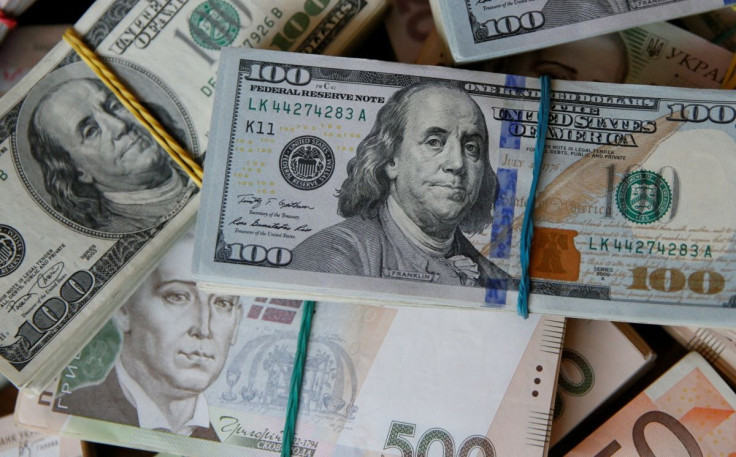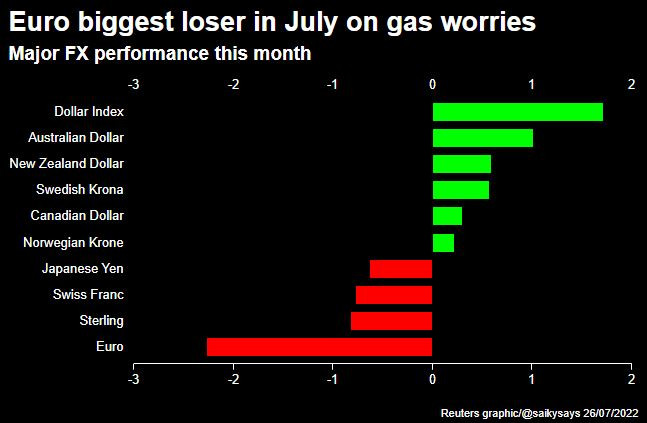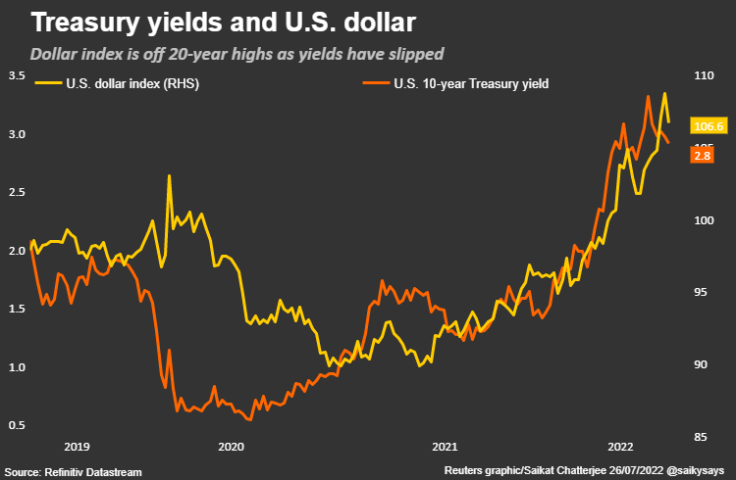Gas Crunch Fears Hammer Euro, Lift Dollar And Swiss Franc

The prospect of another Russian gas supply cut knocked the euro lower on Tuesday, while dollar gains were tempered by mounting uncertainty over the U.S. Federal Reserve's policy-tightening path after this week's expected interest rate rise.
European Union countries were preparing to approve an emergency proposal to curb gas demand, the prospect of which sent the single currency and German bond yields lower and hit German shares.
"It's becoming a more mainstream view that the price to pay for supporting Ukraine against Russia will be gas rationing," said Rabobank senior strategist Lyn Graham-Taylor.
"All this adds to the recession and inflation story."
Russia said on Monday it would cut gas flows to Germany via the Nord Stream 1 pipeline to 33 million cubic metres per day (bpd) from Wednesday. That is half of current flow, which is already only 40% of normal capacity. [
By 1045 GMT, the euro was down 0.7% at $1.0142 and against the pound it had lost 0.3% at 84.6 pence. It also shed 0.8% against the Swiss franc, plunging to a new seven-year low around 0.977 francs.
GRAPHIC: monthly G10 FX (

)
The euro remains above parity versus the dollar, hit earlier this month, but ING Bank strategist Francesco Pesole warned that traders could start repricing rate hike expectations from the European Central Bank.
Money markets now see a 39 bps ECB rate hike in September, versus 50 bps last week and see around 100 bps by year-end, which Pesole says is too hawkish.
"The Russian gas story is the black swan risk, a constant threat," he said.
"Even if gas flow is not completely shut down and it doesn't come to rationing, a lot of damage has already been done to the European economy."
Citi analysts agreed, noting Monday's dismal IFO business survey from Germany "was most likely driven by mere uncertainty about the future of Russian gas supply".
The latest supply reduction "will at the very least keep that uncertainty elevated", they added.
The dollar, meanwhile, ticked up, rising 0.6% at 107.08, a four-day high against a basket off currencies, though it remains more than 2% below the 20-year highs of 109.29 hit less than two weeks ago.
The U.S. Federal Reserve starts a two-day meeting later in the day and will almost certainly deliver a 75 bps rate rise. But traders are assessing whether softer growth may see it signal a slower rate hike pace ahead.
Futures tied to the Fed's policy rate show rates peaking in January 2023, a month earlier than the February reading they gave last week, while long-dated Treasury yields have fallen some 80 basis points off mid-June highs.
GRAPHIC: Dollar and yields (

)
Pesole said traders had cut excessively 'long' greenback positions as they re-assessed U.S. terminal rates.
However, most analysts still retain a bullish dollar view, with global economic slowdown fears reinforced by soft data prints and Monday's profit warning from U.S. retailer Walmart.
"There is less scope for dovish repricing at the Fed compared to the ECB... Fed pricing is more or less in line with the dot-plot and the inflation/growth outlook," Pesole added, referring to the chart recording each Fed official's interest rate projection.
Elsewhere, commodity prices had allowed the Australian dollar to reach a one-month high of $0.6984 before dollar strength knocked it back to $0.6943.
Wednesday's inflation data may show consumer prices rising 6.2% year-on-year, the fastest in more than three decades, which ANZ Bank analysts said could fuel some Aussie upside.
"A 50 bps hike from the (Reserve Bank of Australia) next week is all but a foregone conclusion - the main risk is for a larger hike," they added.
© Copyright Thomson Reuters 2024. All rights reserved.











